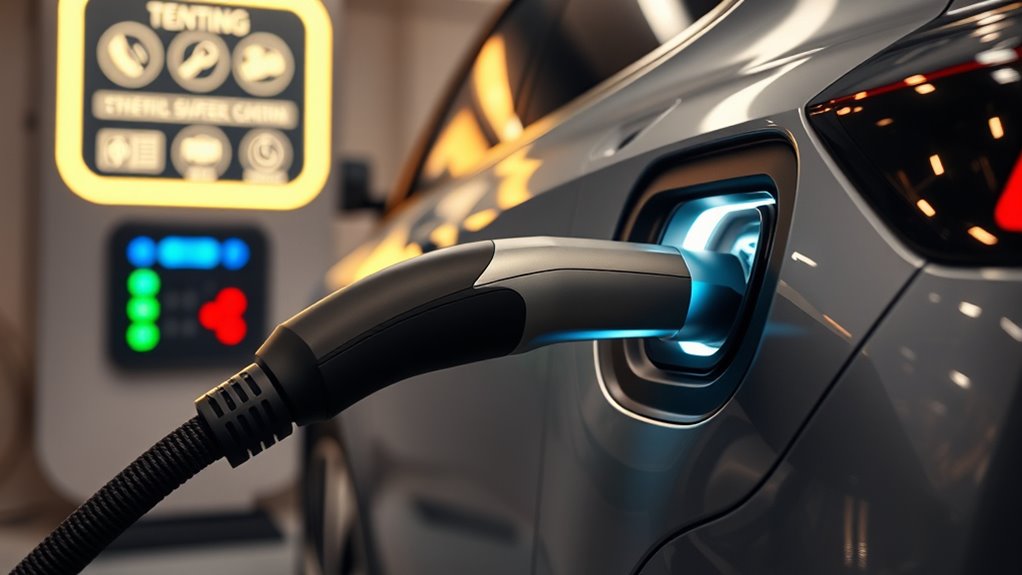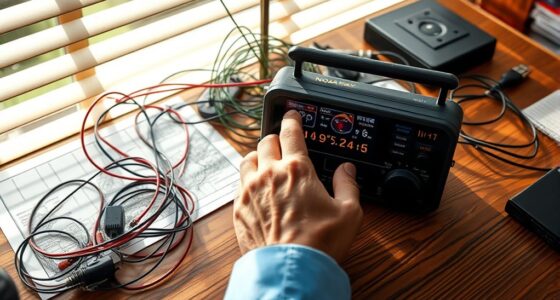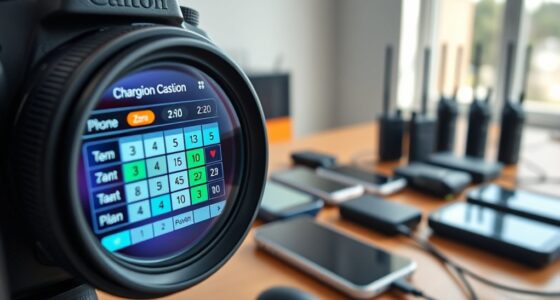To safely charge your devices in your car, know your charging ports’ limits, and always use certified accessories designed for automotive use. Follow your vehicle’s guidelines, adhere to electrical codes, and avoid overloading the system. Practice safe habits like unplugging devices when not in use and inspecting cords regularly. Paying attention to these rules keeps your devices and vehicle safe—keep going to learn more tips to stay compliant and secure.
Key Takeaways
- Always use manufacturer-approved chargers and cables to ensure device safety and compliance with vehicle electrical standards.
- Verify port types and power limits in your vehicle’s manual before connecting devices to prevent overloading.
- Follow local electrical codes and city regulations for proper installation and safe charging setups.
- Regularly inspect and maintain charging accessories and ports to detect damage and ensure reliable operation.
- Avoid simultaneous charging of multiple devices beyond the vehicle’s capacity to prevent electrical hazards and system damage.
Understand Your Vehicle’s Charging Ports and Their Limits

To guarantee safe and efficient device charging, it’s important to understand your vehicle’s charging ports and their limits. Vehicle port types vary widely, including USB ports, 12V sockets, and specialized charging outlets. Each port type has specific charging limits, which determine how much power they can supply safely. Exceeding these limits can damage your device or the vehicle’s electrical system. Before plugging in, check your vehicle’s manual to identify the port types and their maximum output. Knowing the charging limits helps you avoid overloading ports and ensures your devices charge efficiently without risking safety. Being aware of these details allows you to make informed decisions, prolongs device lifespan, and maintains your vehicle’s electrical integrity. Additionally, understanding the electrical system of your vehicle can help prevent potential overloads and ensure safe charging practices.
Use Certified Charging Devices and Accessories
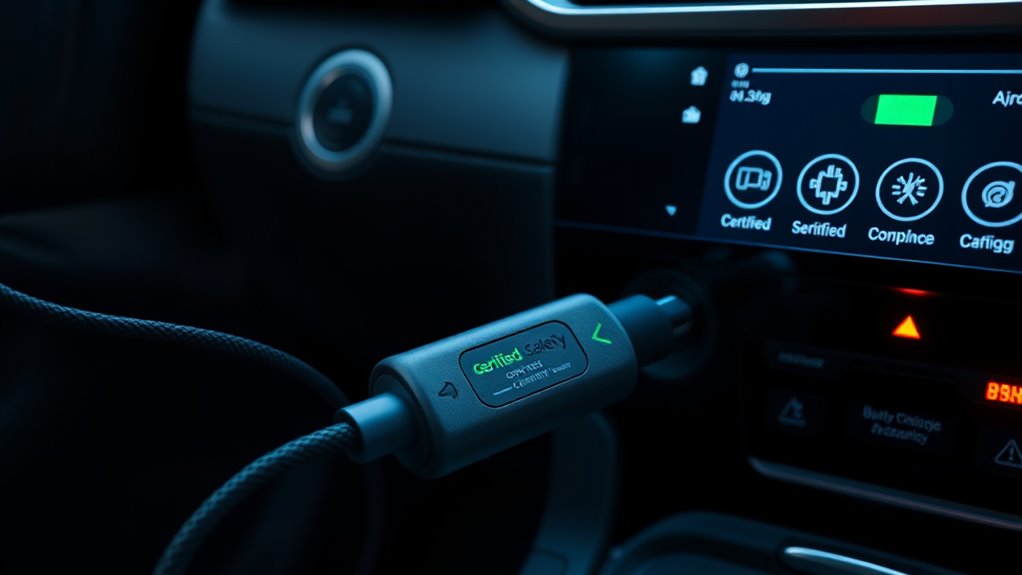
Using certified charging devices and accessories guarantees your devices charge safely and efficiently. When choosing accessories, prioritize those that meet safety standards to avoid damage or hazards. Consider these key points:
- Use original or certified wireless charging pads to ensure compatibility and safety.
- Opt for portable adapters with proper certifications to handle power fluctuations.
- Avoid cheap, uncertified cables and chargers, which can cause overheating or damage.
- Incorporate exfoliating skincare principles to maintain optimal device and accessory performance over time, as clean and well-maintained components function more reliably.
Certified accessories help prevent issues like short circuits or slow charging. Wireless charging is convenient, but only if your device and pad are certified. Portable adapters are ideal for on-the-go charging, but they must be certified to deliver consistent power. Always verify the certification marks before purchasing or using any accessory. This simple step safeguards your device’s health and ensures compliance with safety standards.
Follow Manufacturer Guidelines for Device Compatibility

Always check your device’s specifications before plugging it in to guarantee compatibility. Use chargers that are approved by the manufacturer to prevent damage or safety issues. Following their recommendations helps you charge safely and keeps your device working properly. Incorporating visual and auditory cues from speech therapy techniques can also enhance understanding of device functions and proper usage.
Verify Device Specifications
Before plugging in your device, it is vital to verify that it meets the manufacturer’s specifications for charging. Ensuring device compatibility helps prevent damage and maximizes charging speed. To do this effectively:
- Check the device’s voltage and current requirements against the charger’s output.
- Confirm that the charger supports your device’s charging protocol for peak performance.
- Read the manufacturer’s guidelines for recommended charging accessories and methods.
- Consider the Vetted products and their specifications to ensure optimal performance and safety. This verification process guarantees your device charges safely and efficiently, avoiding potential issues caused by incompatible chargers. By following these steps, you maintain your device’s health and achieve the best charging speed possible. Always prioritize compatibility to keep your devices functioning properly and to adhere to safety standards.
Use Approved Chargers
Selecting the right charger is vital to guarantee your device charges safely and efficiently. Always choose chargers that are officially approved for your device, making sure they meet safety standards and have proper device certification. Using certified chargers minimizes the risk of charger safety issues, such as overheating or electrical faults, which could damage your device or cause hazards. Avoid generic or unbranded chargers that lack certification, as they may not deliver consistent power or could pose safety risks. Approved chargers are designed to match your device’s power requirements, helping maintain ideal charging performance. By sticking to manufacturer-approved chargers, you ensure your device’s longevity and safety while adhering to proper charging protocols. Remember, using the right, certified charger is a vital step in responsible device management. Incorporating user-friendly interfaces from reputable charging brands can further enhance your charging experience and provide additional safety features.
Follow Manufacturer Recommendations
Following manufacturer recommendations is essential to guarantee your device charges properly and safely. Ignoring these guidelines can compromise device safety and lead to charging issues. To practice proper charging etiquette, keep these points in mind: 1. Always use the charger and cable specified by the manufacturer to ensure compatibility. 2. Avoid using third-party accessories that aren’t certified, as they may damage your device. 3. Follow recommended charging voltages and durations to prevent overheating or battery degradation. Additionally, understanding self watering plant pots can help you appreciate the importance of proper system design and maintenance.
Be Aware of Electrical Codes and Legal Regulations
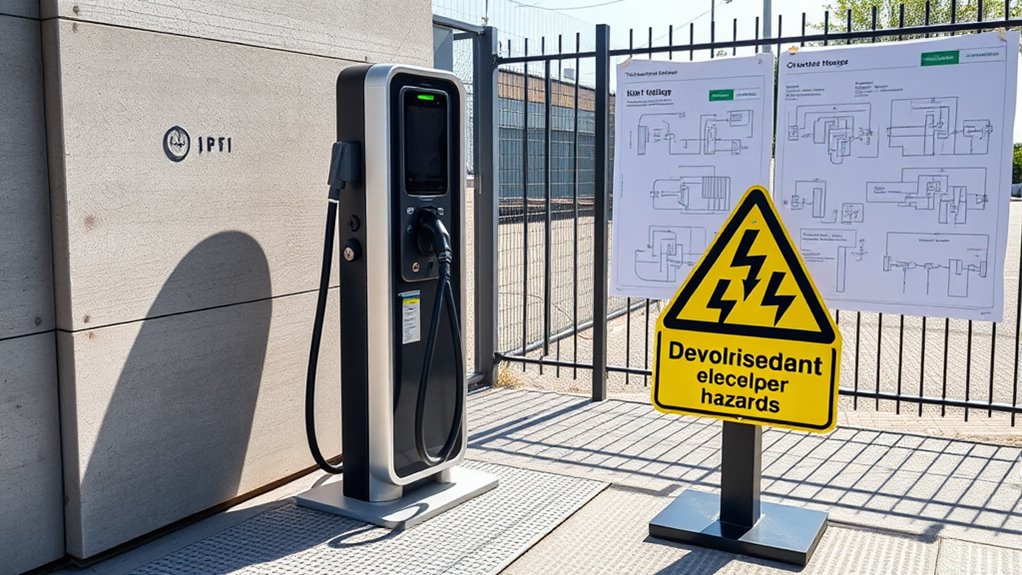
You need to make certain your charging setup meets local electrical codes and legal standards. Ignoring these regulations can lead to fines or safety hazards. Always check with authorities to stay compliant before installing or modifying your car charging system. Additionally, understanding home security system costs and regulations can help ensure your setup remains safe and compliant with local standards.
Local Code Requirements
Are you aware of the specific electrical codes and legal regulations that govern the installation of car charging devices? Local code requirements can vary widely, so it’s vital to understand your area’s rules. These often include:
- Reviewing municipal regulations to ensure compliance with zoning and safety standards.
- Securing necessary permits before installation, which may involve inspections.
- Meeting licensing requirements for electrical work, ensuring licensed professionals handle complex tasks.
- Considering the impact of spiritual practices on your overall well-being, which can influence your approach to safety and mindfulness during installation.
Failing to follow these local codes can lead to fines, delays, or even the removal of your charging station. Always check with your local building department or municipal authorities to confirm the specific rules applicable to your property. Staying compliant protects you legally and ensures your charging station operates safely.
Legal Compliance Standards
Understanding and adhering to electrical codes and legal regulations is vital when installing a car charging station. These standards ensure your setup meets safety requirements, especially concerning battery safety and charging station standards. You must confirm that your installation complies with local, state, and national electrical codes to prevent hazards. Properly rated wiring, circuit breakers, and grounding are essential for safe operation. Regulations often specify the types of equipment you can use and how they should be installed. Ignoring these standards can lead to fines or unsafe conditions. Staying informed about legal compliance helps protect you, your property, and future users. Always consult a qualified electrician and review relevant codes to ensure your charging station installation is safe, legal, and reliable. Understanding city regulations can also help you avoid unexpected legal issues and fines.
Avoid Overloading Your Vehicle’s Electrical System
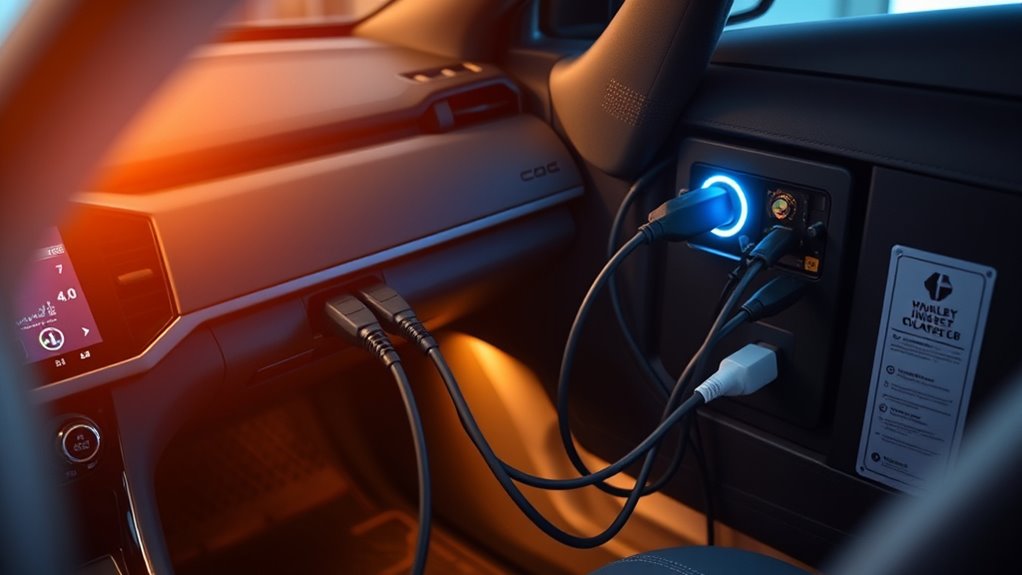
To prevent damaging your vehicle’s electrical system, it’s essential to avoid overloading it with too many devices at once. Overloading can cause electrical failures or reduce your battery life. To practice good charging etiquette and ensure safe portable power use, follow these tips:
Avoid overloading your vehicle’s electrical system to prevent damage and extend battery life.
- Limit simultaneous device use to match your vehicle’s power capacity.
- Use approved adapters and chargers designed for automotive use.
- Monitor your system’s load, especially when charging multiple devices, to prevent overloads.
- Be aware of your vehicle’s electrical system capacity to avoid potential damage.
Practice Safe Charging Habits to Prevent Damage and Hazards
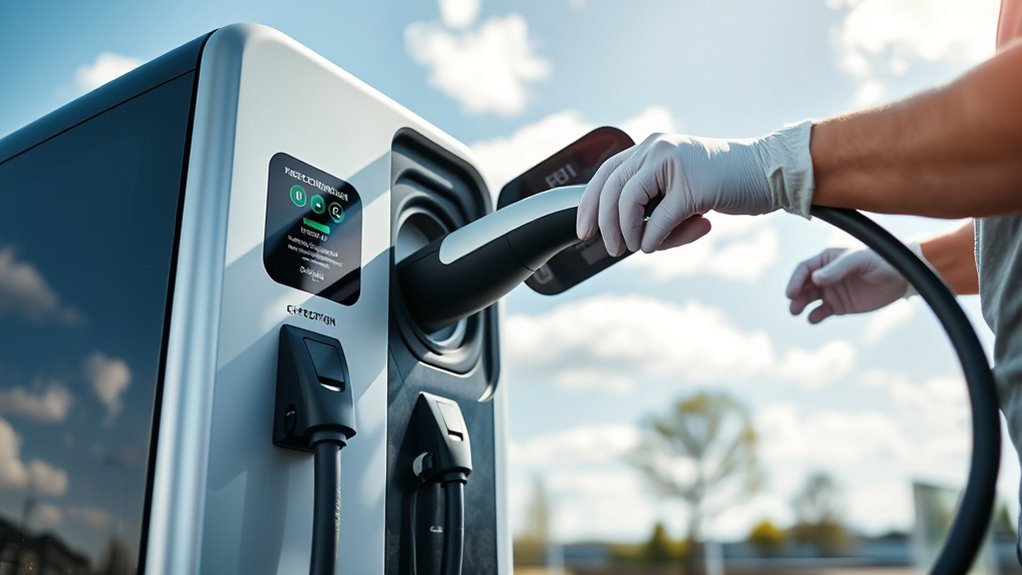
Practicing safe charging habits is essential to prevent damage to your devices and reduce safety hazards. Proper charging safety involves using compatible chargers and avoiding cheap, low-quality cables that can cause overheating or short circuits. Always unplug chargers when not in use to prevent unnecessary wear and potential electrical issues. Keep charging ports clean and free of debris to ensure reliable connections and protect your device from damage. Don’t force connections or use damaged cords, as this can compromise device protection and increase the risk of electrical fires. Be mindful of the charging environment—avoid charging in wet or humid areas. By following these habits, you safeguard your devices and create a safer charging experience for yourself and your vehicle.
Regularly Inspect and Maintain Charging Equipment and Ports
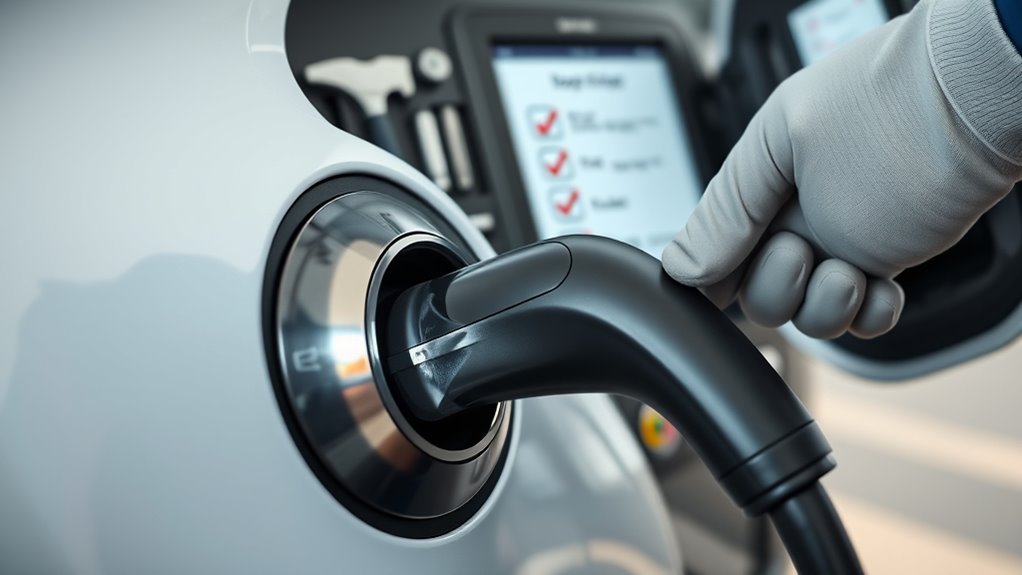
Regularly inspecting and maintaining your charging equipment and ports is essential for safe and reliable device operation. This helps prevent issues like power surges and ensures ports stay clean for maximum contact. To do this effectively:
- Check for signs of wear or damage to cables and chargers.
- Clean ports carefully to remove dust, dirt, or debris that can cause poor connections.
- Test charging equipment periodically to detect potential power surges or malfunctions early.
Maintaining port cleanliness reduces the risk of poor contact or short circuits. Inspecting equipment regularly helps you catch damage before it affects device performance or safety. Staying proactive ensures your charging setup remains safe, efficient, and compliant with standards.
Frequently Asked Questions
Can I Use Third-Party Charging Accessories Legally in My Vehicle?
Yes, you can use third-party accessories legally in your vehicle, but you need to prioritize charging safety. Make sure the third-party accessories meet safety standards to avoid risks like overheating or short circuits. Always check for proper certification and compatibility with your vehicle’s charging system. Using certified accessories helps guarantee safe charging and prevents potential damage or hazards, keeping you and your device safe on the road.
What Are the Specific Electrical Codes I Need to Follow?
You need to follow specific electrical standards and safety regulations to guarantee your vehicle’s charging setup is compliant. Check that your accessories meet the National Electrical Code (NEC) requirements and are rated for automotive use. Avoid shortcuts, as non-compliant chargers can pose fire hazards or damage your vehicle’s electrical system. Always verify that your device installations adhere to local code mandates to keep yourself safe and avoid legal issues.
How Do I Identify if My Device Is Compatible With My Car’s Charger?
To identify if your device is compatible with your car’s charger, check the device’s compatibility information and guarantee it meets the charging standards specified by your car. Look for labels or manuals indicating supported charging protocols like USB Power Delivery or Quick Charge. Confirm that the voltage and current ratings match your device’s requirements. If these align, your device should work safely and efficiently with your car’s charger.
Are There Any Warranties for Damaged Devices Caused by Charging Issues?
You’re probably aware that warranty claims for damage liability caused by charging issues are rarely covered by manufacturers. Studies show only about 15% of warranty claims for device damage relate to charging problems. If your device gets damaged due to improper charging, most warranties don’t cover it. Always check your warranty policy beforehand, and consider third-party insurance for added protection, since manufacturers often exclude damage liability from standard warranties.
What Should I Do if My Vehicle’s Charging Port Stops Working?
If your vehicle’s charging port stops working, start with charging port troubleshooting by inspecting for debris or damage. Try cleaning the port gently and testing with a different charger. If it still doesn’t work, consider alternative power sources like portable chargers or power banks to keep your devices charged. If problems persist, consult a professional technician to diagnose and repair the port, ensuring safe and reliable charging.
Conclusion
By following these simple rules, you’ll keep your devices happily powered and your vehicle running smoothly. Think of it as gentle guidance that helps avoid unexpected hiccups and keeps your journeys stress-free. With a little care and awareness, you’ll enjoy seamless charging without ever missing a beat. After all, a little attention today can lead to trouble-free adventures tomorrow—making every trip a smooth ride you can truly trust.
